5 Cars That Prove There’s Love for the Unexceptional
Almost ten years ago, I was part of the team that gave birth to a much-loved Hagerty U.K. event: The Festival of the Unexceptional. FOTU, to this day, is a celebration of extraordinary examples of the most mundane—and in some cases, plain disappointing—automobiles ever built. The event made people realize how low the survivorship rate is for many of these generally unloved cars. These days, the market is perhaps finally waking up to the fact that many of the cars that were the butt of jokes—the rides that were the one-time Nickelbacks of the automotive world—are now legitimately rare and interesting collector cars. Lately, we’ve taken note of some eye-popping sales (and enthusiastic bids that somehow didn’t meet reserve) of what are, almost certainly, the sweetest examples of some of the most maligned cars ever made. We submit these for your disapproval:
1977 Chevrolet Chevette
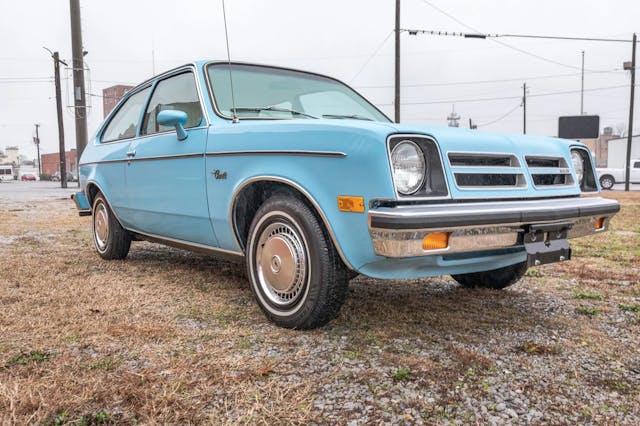
Sold for $22,050
When the Chevette debuted in the U.S. for the 1976 model year, it already seemed like a vestige of a prior era. It was rear-wheel drive at a time when small cars like the Fiat 128 and VW Golf/Rabbit had demonstrated that the future of the compact car was in powering the front wheels. The Chevette was middling but apparently sturdy, until rust claimed almost all of them.
This light blue one showed 5000 miles on the odometer and was lavishly equipped with full wheel covers and an AM/FM radio. Oh, and it had A/C too, something which no doubt sapped at least 15 of the 60 available horses. The shocking final price of $21,000 reflects the fact that while these cars have all but disappeared, nearly everybody of a certain age seems to have a fond Chevette story. Good memories in maligned cars are still good memories.
1976 Chevrolet Vega
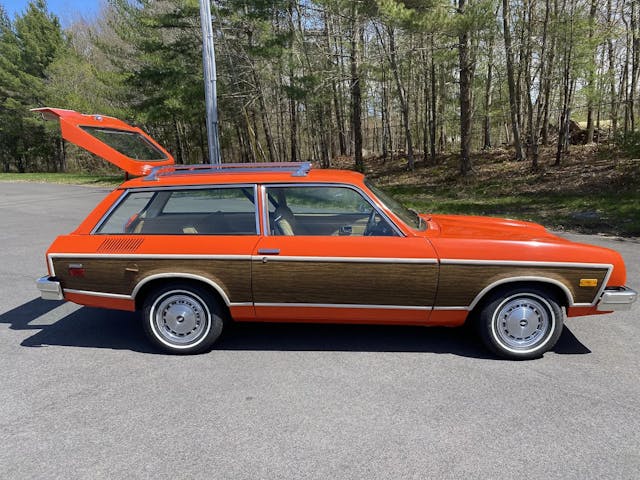
Sold for $12,337
The Vega was less of a joke than a genuine Greek tragedy. It could have been a really decent car but for GM’s dreadful execution. It was pretty, handled well, and it was affordable. Sadly, the prone-to-overheating aluminum-block engines had a two-stroke’s appetite for oil, and the only way in which Vegas were competitive with Toyotas of the day was in their penchant for the tin worm.
True story: My best friend in high school owned a five-year-old Kammback just like this one. It only had 40,000 miles on it, but it used a quart of oil with nearly every fill-up. The car’s cowl had rusted so badly that the windshield was slipping down towards the firewall, leaving a half-inch gap at the top where air would rush in. My solution was to wad up some newspaper to prop up the piece of glass. Pretty elegant if I do say so myself. This example is almost impossibly rust-free, especially for one with 70,000 miles. For heaven’s sake, there’s even a receipt for rebuilding the 8-track player. And that pretty much explains the car’s state of preservation. The new owner shipped it to France, where it’s reputed to be the only one in the country.
1989 Maserati BiTurbo
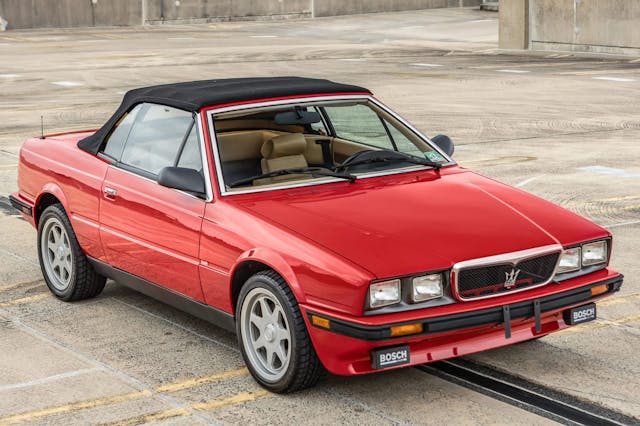
Bid to $16,750
The BiTurbo had among the worst reputations of cars sold in the U.S. in the 1980s. Early carbureted examples had a propensity to catch fire from running too rich of a mixture through the cats, and the fallout nearly destroyed Maserati’s status as a prestige brand. I suppose it made sense at the time; the BiTurbo was positioned as a more potent, more luxurious, and slightly more expensive competitor to the E30-generation BMW 3-series. Instead, to many, it came off as a cynical cash grab by Maserati’s owner, Alejandro De Tomaso. To my eyes, it also looked disturbingly like a Cadillac Cimarron.
More of these cars seem to survive in Europe, where they are unencumbered by emission controls and their mechanical bits are better understood. In the U.S., most BiTurbos tend to be of the “ran when parked” variety, perhaps discovered when the new owner of a distressed property cuts the grass for the first time in ten years. This example was a later, much-improved fuel-injected car that attracted a bid over fifteen grand.
1969 Subaru 360
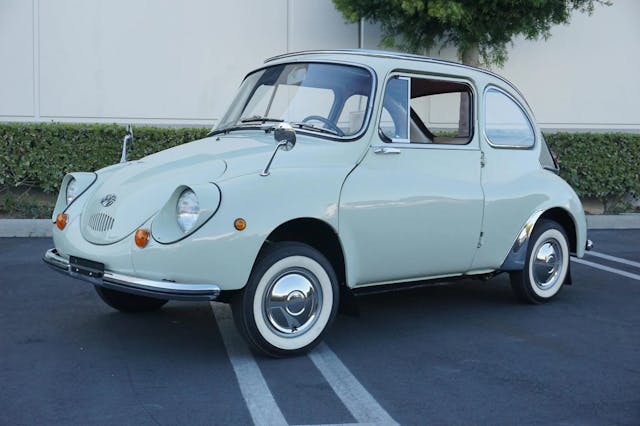
Bid to $35,500
Road & Track summed up Subaru’s first effort in the U.S. thusly: “Any car that takes over 27 seconds to cover a standing quarter-mile, and is only going 46 mph at the end of that quarter, has no business in American traffic.” Consumer Reports said that the bumpers were ineffective against anything sturdier than a watermelon. Until the Yugo came along several decades later, the 360 was probably one of the most scorned new cars ever to be tested by U.S. magazines.
Today, it’s largely forgotten by everyone, including Subaru. Surviving U.S. market cars are indeed unicorns and, as such, are likely to attract more attention at your local cars and coffee than a Koenigsegg. Still, it’s nearly incomprehensible that even in a heady 2022 market, a $35,500 bid wasn’t enough to get this car sold. (To read our 2021 market deep-dive on the surprising Subaru 360, click here.)
1980 Pontiac Phoenix

Sold for $17,587
Entire books have been written for the sole purpose of excoriating the GM X-cars. They were GM’s first mass-market front-wheel-drive sedans, and they had immense potential to be very good cars. In fact, they initially sold quite well. But it’s called the Malaise Era for a reason, so you know how this story ends—”ignominiously” is probably too kind of an adverb.
GM made a number of tweaks to the X-body’s braking system before the new platform entered production, but it didn’t take long for problems to arise. “Media criticism and consumer complaints of X-car stability during braking” drew the National Highway Traffic Safety Administration’s attention, according to an internal NHTSA memo dated June 26, 1981. A lengthy and public back-and-forth ensued between the agency and GM about how to resolve the issue, and the public quickly soured on the cars. Braking wasn’t the only issue, either—the cars were prone to rust, and quality control was lacking. It was an unfortunate misstep in the pivot to more economical front-wheel drive architecture.
Extant X-cars of any variety are rare, and this four-speed manual, nicely equipped 32,000-mile Pontiac Phoenix, with a lurid red velour interior, an insanely full gauge package, and a CB radio, might just be one of the best X-cars left. The price: over $17,500 with the buyer’s fee. Remarkable!
***
Check out the Hagerty Media homepage so you don’t miss a single story, or better yet, bookmark it. To get our best stories delivered right to your inbox, subscribe to our newsletters.
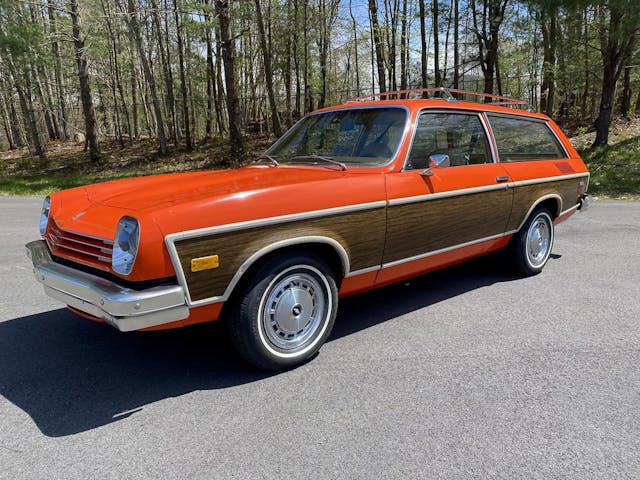


Just like the Vega story I had a 71 Pinto for a winter beater I bought for $150 when it was five years old. Lots of plywood in the floor. No rear quarters left to speak of. That being said it was a three year beater–and sold to a huge biker for $175. Thank the Lord I never saw him or the car again! My 19 year old Denali does not have 5% of that rust. I’m seeing a lot of rust on 5-6 year old vehicles again like in the 70s. Maybe selling our steel industry to Japan isn’t such a good idea.
I had a ’71 Pinto and drove it until the shift lever pulled out of the floor and transmission housing. Luckily I got it back into the linkage and made it home. I then transitioned to a 1st year Fiero for a year, and then one of the 1st V6s with the Muncie 4 speed.
That brine that northern New York state puts on the road rusts cars and truck phenomenally fast – at least twice as fast as across the St Lawrence river in Ontario.
I’m not sure the stuff New Jersey puts on is any better. A few months ago, they tried to put my 2010 Tacoma on a lift. You could hear the crunching sounds in the waiting area. The frame has rusted out. I ran it up on ramps to fix that particular problem, but it’s due for its 70K checkup and I’m not sure my mechanic will be willing to tackle it again.
Isn’t that one of the trucks Toyota had a frame recall on and was replacing them for free..?? Remember hearing about it and seeing stacked up new frames behind my local dealer…
Yep, but they never sent me a recall notice. I found out about it after the deadline expired. I’m done with Toyotas.
Howdy,
After the frame on my 1994 Chevy K1500 Z71 pick up gave in on me as I was putting it up on the lift, I replaced it with a 2010 Tacoma with a frame that was replaced under the recall 4 years ago. That all happened about six months ago. I would check with your nearest Yota dealer asap…
Just my 2 cents. Good luck, hope this helps.
K-Lap
I’ll try, but I was told the recall expired last year.
Don’t give up. Not your fault if they didn’t get notice to timely, but even if they did, keep pushing it. Toyota knows they have a problem and the frame didn’t suddenly rust after the deadline expired. Post about it on social media devoted to Toyo trucks, that often helps. Be polite but persistent.
Toyota cannot afford to have you going down the road and have the frame fold on you leading to a MASSIVE lawsuit. I understand what your saying about the recall deadline. I have a 1994 4Runner that a steering link was under recall that had expired, but Toyota replaced it under warranty, again, it’s in their best interest to fix it rather then have a death caused by one of their vehicles
Toyotas was replacing the entire frames on them
Maybe putting hefty tariffs on good quality steel imports wasn’t such a good idea.
My grandpa but a red Vega the first year they came out. After a year there were holes in the tops of both front fenders from rust. He was not a happy man.
Those holes in the top of the front fenders, were caused by a small shelf in the inner panel where the front wheels deposited a large amount of salty mud. My 1972 Vega GT was cursed with those holes and the aluminum engine was consuming a lot of oil during an oil crisis! I tornado’s mug sized hail put it out of its misery.
I purchased a Pontiac Phoenix off the dealer’s lot as a work car. One glaring defect left a rather large run in the paint below the gas filler door, which I didn’t bother getting fixed. It was a stripped-down car with 4 cyl, 4 speed manual, no air, and it was BROWN. Someone had ordered it and refused delivery, and the dealer made me an offer I couldn’t resist. Two years later, my company gave me a company car and I sold the Phoenix for peanuts.
Malcom Bricklin brought the Subaru into the US right after he gave us the Yugo.
I sold Vegas new in 76. They had rust spots on the showroom floor.
Many of the rust problems occurred before these automobiles were assembled. The coils of steel and the bare frames were stored in the elements. Even with the “Rusty Jones’s” application they were doomed.
Finally, the industry developed “E Coating to the steel prior to stamping and redesigned areas of the joints to prevent moisture collection.
However, I still see many newer vehicles fall to panel cancer in the mid-west.
Bricklin chronology is a bit off — he brought the 360s into the US about a decade and a half before gracing our shores with the Yugo.
I worked in GM dealers when the Vega was brand new, needless to say they kept us busy. I always thought if somebody did one of those Zeibart deals that maybe they wouldn’t have rusted out so bad.
Ziebart didn’t help the Vega at all. My 71 rusted at the top of the fenders after a couple of years, but Ziebart did stand up to their warranty and replaced the fenders for free. So I traded it on a new 74 Blazer while it still had paint on it. (Had the Blazer rustproofed too). One New Jersey winter and one in SC and that was rusted through as well! Once again I had it fixed and then traded even up for a 1974 Lotus Europa. Figured that fiberglass was the answer, but that car was so unreliable that rust was the least of my concerns!
Yes, GM cars in the 70s just seemed to dissolve right in front of your eyes.
Nope …A friend of mine bought one brand new that had been Zeibart’d by the dealer. (Not dealership rust proofing … actual “Zeibart” that the dealer had done.) He got “a deal” because it was last years model but brand new with no miles. 2 weeks after the purchase he was on vacation in Canada, the back window fell “in” & the tops of both front fenders rusted through. I saw the car a month after the purchase and there was so much rust it was had to tell what color it was.
I was on my way from home to a nearby Chevy dealer to buy my 1st car in 1972 when I drove by another local Buick/Jaguar dealer with a small sign out front advertising a car I had never heard of, “Subaru”. I stopped and as people say, the rest is history. Bought a 72 Subaru ff-1 1300g and never looked back on American cars. Dodged a true bullet with that decision. The Subie was so far ahead of any of the domestics at the time it was scary. However, living in the salt encrusted CNY at about 105k it to became unsafe from underbody rust but it was a story of loving your 1st car as it never let me down.
My sister bought a red Vega, she told me she was hearing “noises” in the trunk, I raised the trunk lid there was easily two feet of water, felt around under the spare tire, pulled a plug, gallons of water spilled to the street… no more noise…we should have been so ashamed at the models that US outfits put out, how embarrassing.
Rust today is about a 12-15 year thing in the rust belt. In the 70’s it was 3-5.
What is funny is what some will pay for the odd car now and then. Or the number of people that are part of a particular brand of car.
I was shocked that you can go to a Camaro, Chevelle or Mustang national event and find 50-100 cars attending the event. Yet when I have attended a number of national Fiero Events they draw 200-300 cars even now years later.
Participation is not what you think with some brands but others it is great.
The Pontiac Nationals here in Ohio draw 600 plus drag cars and 600 plus show cars. they nearly have 1500 car every year. There are many Ford and Chevy events that never come close to this.
I am glad GM dropped Pontiac in this era of FWD SUV models. I hope that if it goes back to cars they can bring the brand back then with real performance models.
Gm got rid of Pontiac and kept the Buick, because the Chinese love Buicks.
I don’t think you do anyone any help by listing “high bids” that do not meet reserve. In most cases, even at live high end auctions with reserves, the final bids are fake, made up by either the consignor’s friends or the auction company itself.
Chevette and Vega? Why would anyone want one of these p.o.c.?
We bought 3 New Vega Panels for pizza delivery in the mid 70’s Worked very nicely and the panels gave use a natural place for our sign lettering. I drove one home and to work daily, they drove fine, and good MPG. They were a pretty good delivery rid.
All of these cars were rust prone, poor quality and design, lackluster performance cars back then. Why anyone would spend money on them now is a mystery to me.
A couple of these are garage finds. The kind of car Grandma bought and when she passed Grandpa kept it but never drove it. It is now up for sale as he has passed 30 years later.
This is how I got a 1963 Galaxie for $500 with original paint and even the original exhaust with $60K miles. The owner passed and his wife after a few years decided she did not want it anymore. It was not a cool car but a set of Ansen wheels from the 60’s a decent set of tires and it made a nice looking car. for less than a grand.
Just to make you all cringe, Baldwin-Motion built 454cid Vegas at one time.
The Vega was the same platform as the Monza and the Monza could be ordered with a small block chevy, a 265 ci, but the same motor design as the 350. you could easily drop a 350 into a Vega using the Monza engine mounts.
Not 265 , 267 cubic inch.
Junk engine.
The 305 was available in a Monza.
GM engineers, in their infinite wisdom, designed the Monza for a 4-6 cylinder, some genius at GM decided to drop a small V8 into the Monza to make it “sporty” only problem the extra weight dropped the engine even with the frame so #1 spark plug couldn’t be accessed… their arrogant response, “drill a hole in the frame or jack up the motor “can’t make this stuff up.
I had a 75 Monza 2+2 with the small V8. It was a rather quick sleeper, especially once the 2 bbl was swapped to a 4 bbl. Having to lift the engine for changing the plugs was not much fun though!
Wait a sec, guys. Some Monza misinformation is out there.
I owned a ’75 Monza 2+2 with the California-only 350, brand new in 1975. My high school senior car that I got a lot of tickets in.
I learned how to drive fast and smooth in that car, because its brakes (stock Vega 10″ solid-rotor front discs and 9.5″ drums) were practically non-existent, and so I had to anticipate the road ahead. I learned this the hard way, after going completely through a (fortunately not too busy) red light intersection at over 60 mph due to having lost the brakes while I was street racing a guy in a ’69 GTO. We’d just topped 100 mph when the light about 250 feet ahead changed to red. The GTO managed to stop, but I whizzed through the red light with the brake pedal mashed to the floor, brake fluid boiling, and achieving about zero deceleration, as I swerved around the crossing vehicles. Once I got the car stopped, my buddy (a self-proclaimed “badass”) had to get out and sit on the curb, as his knees were shaking so much from the close call.
Fast forward to today: I recently bought the ’75 Monza 2+2 that Microsoft’s Paul Allen paid over $70,000 to restore about ten years ago. It is a duplicate to his first-ever car, and is mentioned in his autobiography several times. It is very close in appearance to my first Monza, with blue paint, and I feel very fortunate to own it. He had a shop that restores Ferraris do the work, then only drove it about 200 miles before parking the finished car in his hangar next to his Ferrari Enzo and Gulfstream jet. I have the photos.
Back to the 350 Monza history: The reason for this rare (around 2000 cars built) engine option: The new 262 (not a 267) V8 developed for the car couldn’t pass emissions in CA. So, rather than slogging along with only the 4-banger in CA, Chevrolet whipped-up some fast “patch-this, reinforce-that” engineering (a larger radiator being one necessary item) and dropped in the (same size externally as the 262 ) 350, with a two barrel carb.
It was rated at 145 hp (same as the ’75 Camaro with the base 350 2-barrel, as it was the same engine) but for some unknown reason, some auto historians have it more recently listed it as having only 125 hp. That is simply not true.
Anyway, it was an easy swap for teenage-me to upgrade to a Holley 650 and Edelbrock take manifold, which really enlivened my original Monza, back in the day, especially after somehow “losing” the catalytic converter and installing straight pipe duals to turn-downs before the rear axle (quiet, inside or out, it wasn’t.)
How I did all that on a $3.50/hour part-time job, I still have no idea. But, man, what a sleeper. Ate up a lot of cars that on the surface should’ve been much quicker. I won’t list them here, to avoid being pelted with rocks (or blown pistons.)
Although the spark plug “thing” is part of the Monza legend, I didn’t ever have to raise the engine or cut a hole in the LF inner fender to access the rear-most (#7) spark plug. By removing the heat shield, then using two universal joints on a small ratchet, connected to a spark plug socket with a notch cut in it, I could, in about 45-55 minutes time, R&R that rear-most plug. I’d put about on par with the difficulty factor of the rearmost plug on an FE Ford in a Mustang, or a ‘C3 Vette 454 with A/C. Time- and patience-consuming, yes, but nothing you really need to cut a hole in the inner fender for.
I’ve always have been, and continue to be, a Monza 2+2 V8 fan. I live in SoCal, so no rust concerns here. Even after owning my first one for 13 years, it was still rust-free.
BTW: The other “thing” about any Monza is (as stated in the owner’s manual) is the warning to owners to not put chains on the rear wheels, for clearance reasons. In my book, that’s a bigger engineering shortcoming than a tough-to-access spark plug.
$3995 for the big block Vega, $2995 for the small block Vega. I remember the ads in some of the car magazines.
I had a friend who said he had a ‘vette. Turns out it was a Chevette. Needless to say it was a disappointment to all and did not survive Chicagoland.
My first car was a 1980 Phoenix, black over gray, honeycomb wheels, and the same red velour interior. Power everything and a pop up sunroof. The throttle body gave constant problems and the CV joints clacked, but I had the best time with that car back in the late 80’s.
You mean Snowflake wheels; yours is a common error, I see it in late 70’s Firebird ads all the time, even though those Pontiac snowflake wheels look
like nothing like Pontiac honeycomb wheels, which look like actual honeycombs.
It’s a nostalgia thing right? Nobody tucked away a Chevette because it was their dream car. Most of these were bought to be used for awhile and then replaced when need be. Sold then after and driven into the ground. So few survive and then the rarity factor comes into play. However if you have fond memories of, bring a smile to your face, why the hell not? People spend a lot more, a lot more, ( price adjusted accordingly ) for a lot less. I might not want one but in the line of more of the sames I’d stop and look at one of these instead. – ‘ I haven’t seen one of these in years and they use to be everywhere! ‘ Hats off to the eccentrics who own them and keep them running.
Well said.
You forgot to include the Cadillac Cimarron on your !
I am truly insulted that my AMC Pacer is not on this list!
As Wayne and Garth would say…….. schwing ! I was in Florida in 1977 and rented ( not by choice ) a 77 Pacer station wagon with woodgrain on the sides, trans went out at 200 miles the rental car company came out with a new vehicle a 77 AMC Hornet 4 door ……… and it was green.
That’s because the cars in this list were notorious for their flaws, the pacer on the other hand while ugly, being compared to a fishbowl or gumball machine was a well built car in comparison.
I am truly insulted that my AMC Pacer is not on this list!
Concerning the Phoenix, I much prefer the 1978/79 X Body Versions.